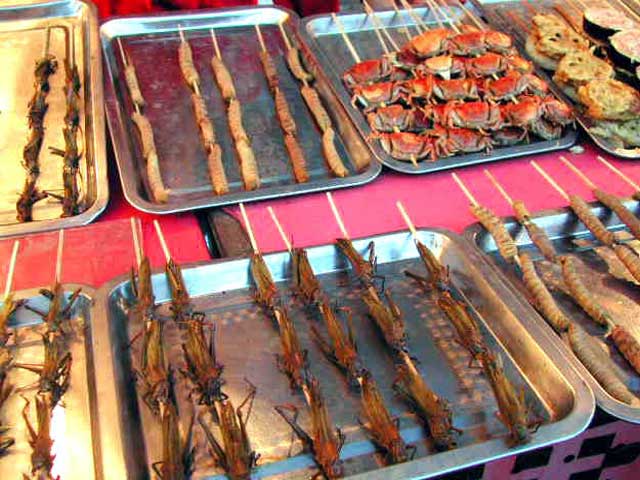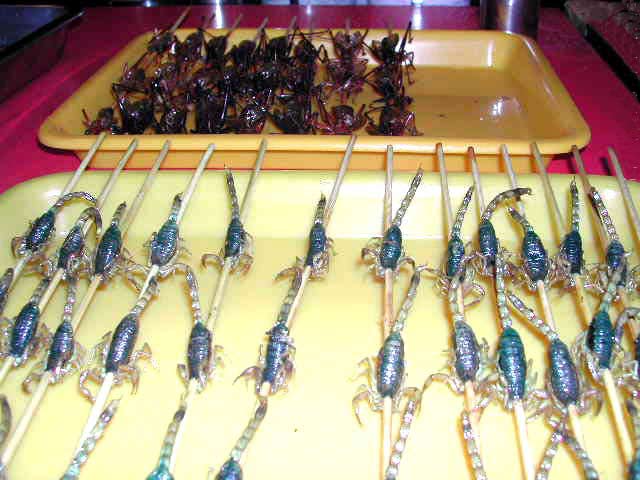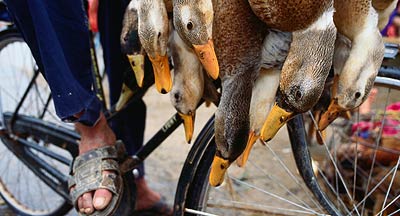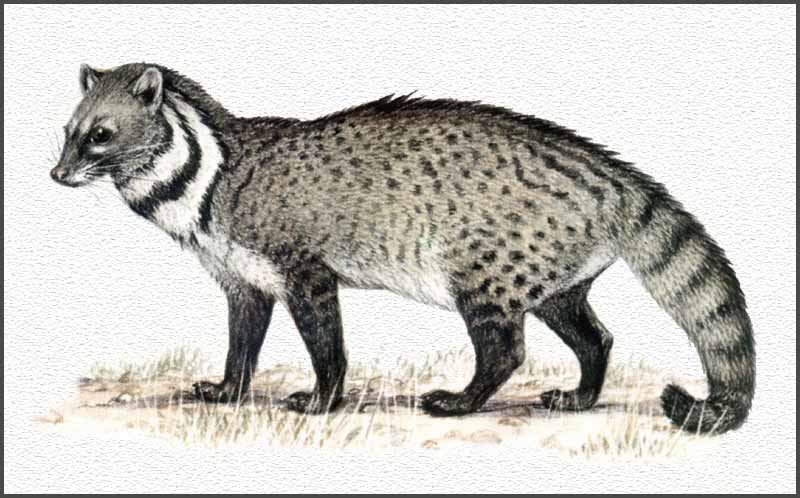Bon Appetit
Staying for Dinner?I have from an early age abjured the use of meat, and the time will come when men such as I - Leonardo da Vinci Edible, adj.: Good to eat, and wholesome to digest, as a worm to a toad, - Ambrose Bierce
by Helen Jones In a letter I just received from a friend in China, she complained about Asian cuisine. It appears that among the many unusual foods consumed on that continent, she found some disgusting. The three she found most repulsive were goose feet, snake and shark's fin soup. However snake is also popular in some parts of Texas ("tastes just like chicken"). As for goose feet, the use of animal feet, whether of fowl or mammal, is quite common. (What puts the gel in Jello, after all?) Europeans use fowl's feet for soups. A friend of European extraction (like myself) told me her mother always used to ask for extra chicken's feet at the butcher to give her soup "more zest and flavour." Her mother also made a tomato sauce to go with the leftover feet and her father used to eat "what little dabs of flesh or cartilage or whatever there is on those things," while the children stood around "making icky noises." Calves' foot jelly is a British delicacy, favoured as a gift for invalids or convalescents. Less understandable is the use of shark's fins for soup, although lately there's quite a fad for these items in alternative medicine circles, as the cartilage is reported to be an anti-cancer remedy. There are reports of fishermen cutting off the sharks' fins and releasing the mutilated sharks back into the sea, presumably to die a slow and painful death. Birds' nest soup, another Chinese delicacy, is actually made from the saliva birds secrete to fasten their nests to the walls of steep caves. Worldwide, the human omnivore consumes a wide variety of protein foods from animal sources:
Food from the sea is also eaten globally.
Next to cannibalism, our chief horror is usually reserved for the consumption of horses and dogs - animals we think of as friends and companions. (It's rumoured that the Bureau of Land Management sends wild horses to slaughter houses in Oregon for export to Europe where horsemeat is in high demand, particularly since Mad Cow disease was found in cattle.) As for dogs, their use as food is common throughout the Orient and was once a staple in the diet of the pre-Columbian Indians. Every year 12 million pets are euthanised in America. Unwanted. Excess animals. In spite of this, people buy dogs at pet stores raised in puppy farms, or from breeders just so they can have pedigreed animals to use as status symbols. (My vet tells us that each week he has to "put down" at least half a dozen healthy animals their owners no longer wish to care for, and every week the local paper publishes long lists of dogs available "to good homes.") As long as these animals are killed anyway, why not use their meat to feed people? (It would give a whole new meaning to the words, Chow Time, Doggie Dinner, and Hot Dog.) After all, your distaste for certain foods is based only on acculturation, and every protein-rich source appears to have been exploited somewhere, at sometime, by someone. Source: Anderson Valley Advertiser 19 November 1997
See also:
Eating out in Vietnam
Hanoi and Ho Chi Minh City - As communism crumbles, a great cuisine revives. In Vietnamese, simple tasks are not as “easy as pie” — they're “like eating dog's brain”. But until recently, eating dog's brain was not easy at all. Vietnam's old communist regime frowned on bourgeois excesses, such as eating out. The few restaurants that survived were drab, soulless spots reserved for party grandees and visiting dignitaries. Anyway, there was not much food on offer. Thanks to a disastrous attempt to force all the country's small family farms to merge into giant collectives, Vietnam flirted with famine in the 1980s. A decent portion of rice, let alone a dog's brain, constituted a feast. Faced with desperate food shortages and a growing exodus of “boat people”, the government undertook tentative market reforms. Its first step was to give peasants secure tenure over the land they farmed, and freedom to sell their crops at a profit. Gradually, other forms of private enterprise won freer rein. The ensuing revolution was not just agricultural, economic and social, but also gastronomic. Ten years ago, there were only three restaurants serving dog along the dyke that protects Hanoi from the Red river; now there are 25. Hungry Hanoians can feast not only on dog's brain, but also sausages of dogmeat with beans and bitter herbs, grilled dog with ginger and shrimp sauce, boiled dog with lemongrass and steamed dog's liver with chilli and lime. Geography determined the basics of Vietnamese food. The vast deltas of the Red river and the Mekong provide the staple, rice, while the strip of coast that connects them supplies abundant fish. Every other aspect of Vietnamese cuisine, however, has changed along with the country's tumultuous history. Chinese invaders introduced chopsticks and soy sauce. French colonists brought coffee, now the country's biggest cash crop. Pressed rice cakes became popular during the war with America, as a durable and lightweight ration. American ice-cream, which had been sidelined by Russian slush, has made a comeback since America and Vietnam re-established diplomatic ties in 1995. Nowadays, free-market reforms are having a profound effect on Vietnamese food, most obviously in terms of the quantity available. In 2000, Vietnam produced some 32m tonnes of rice: more than twice the output of 1987. That huge increase has transformed the country from a net importer of rice to the world's second-largest exporter (after Thailand). Over the same period, production of chicken and pork — and much else — more than doubled. But this plenty is unevenly distributed. A third of Vietnamese children are underweight, and even more are stunted. Ethnic minorities living along Vietnam's mountainous borders with Laos and China are the hungriest, and the north is hungrier than the south. The weather in the Mekong delta (in the south) is warm and wet all the time, allowing farmers to churn out three rice crops a year. The chilly northern winters, by contrast, limit their counterparts in the Red river valley to two. The war's legacy plays a role, too. The south was only subjected to collectivisation for about a decade after reunification, compared with some 40 years in the north, so agriculture suffered less disruption. Many Vietnamese still have to eat whatever they can lay their hands on. Pet birds and dogs are kept indoors to save them from the cooking pot. In 1998, the government tried to reduce the consumption of snakes and cats by banning their sale, since the exploding rat population was damaging crops. Instead, peasants simply took to eating rats as well. The dwindling number of rats, in turn, has caused an explosion in the numbers of another tasty treat: snails. Meanwhile, in nearby Ho Chi Minh city, the country's commercial capital, a recent survey found that 12.5% of children were obese — and the figure is rising. Local restaurants vie with one another in expense and luxury. Hoang Khai, a local businessman, recalls how his family always celebrated at home when he was young, because there was nowhere to go out. He decided to change all that, by ploughing the returns from his textile business into a restaurant lavish enough to suit the city's business elite. The result is Au Manoir de Khai, a colonial villa smothered in gilt and silk where a meal with imported wine can set you back more than most Vietnamese earn in a year. Mr Khai's humbler compatriots are also learning to enjoy their food again. Take Lan, who has been cooking Hanoi's famous beef-noodle soup, pho bo, for over 20 years at a hole-in-the-wall stand in the city's old quarter. She learned the trade from her parents, she says, but never bothered to put any effort into it since the shop belonged to the state. In the 1990s, however, it was sold to an entrepreneur as part of the government's economic reforms. Now she uses only the softest noodles, and stews her beef broth for eight hours before serving — twice as long as before. People are fussier now, she explains, and won't tolerate slapdash service. Of silkworms and goats' testiclesIndeed, Vietnam's culinary renaissance is helping to revive traditions lost during the years of war, famine and repression. Didier Corlou, a French chef who has married into a Vietnamese family, explains how his in-laws eagerly contributed old recipes for his recent book on Hanoian cuisine. Several new restaurants in Hanoi have helped to popularise old-fashioned medicinal wine. Diners at the inexpensive Highway 4, for example, merrily knock back shots flavoured with silkworm, snake, crow or goat's testicles. The food, too, is a souped-up version of traditional mountain cuisine, complete with rural treats such as eel or frog. Even street food is being gentrified: at Quan An Ngon in Ho Chi Minh city, bejewelled ladies wash down their stuffed pancakes and hot-and-sour soup with sips of chardonnay. There are innovations as well as resuscitations. Highway 4 serves spring rolls containing foreign ingredients such as wasabi paste and mayonnaise. These are so popular that several other local restaurants have copied the recipe. Mooncakes, a delicacy sold in the autumn, now come stuffed with chocolate as well as the standard beans and egg. Bars — a foreign concept in Vietnam, where food always accompanies drink — are beginning to spread. Unlike the cheap pubs that draw only men, the comedy acts, raffles and bands at the new nightspots attract both men and women. But the biggest new craze of all is the ubiquitous com, a sort of Vietnamese fast-food joint. Whereas traditional street stalls serve only one dish, com stands offer a wide choice of ready-made toppings to accompany a bowl of rice. Poor Vietnamese, delighted by the variety and convenience, are flocking to them. Not everyone is happy about these changes. Cha Ka Le Vong, a Hanoi restaurant which only serves a thick stew of fish and herbs, has survived three wars, two famines, several attempts at nationalisation, hyperinflation, and the dramatic boom and bust of the 1990s. But the old lady who runs it considers current culinary trends a tougher challenge than any of that. Coms, new-fangled foreign ingredients, and even well-entrenched French imports, such as bread or French fries, are “a threat to our tradition”, she rails. To this day, Vietnam has no McDonald's. But most Vietnamese are adapting to commercial pressures all too readily. Farmers, suddenly paid according to what they produce, are slathering their crops in pesticides to increase their yields. Many Hanoians fear that this may damage their health; the market stalls that advertise “clean vegetables” are doing a roaring trade, even though their wares cost as much as 25% more. Eating pho probably poses a more serious threat, since some unscrupulous merchants try to preserve perishable noodles with formaldehyde or boric acid. Indeed, food scares have become common enough that the World Health Organisation is helping Vietnam to set up a food-safety agency. Other dodgy tradesmen make a fortune serving endangered species to superstitious diners. The menu of the Lamrice restaurant in Hanoi offers a whole roast civet cat for 120,000 dong ($8) or porcupine steamed with ginger for 50,000 dong. Liquor bottles filled with bear paws and tiger penises decorate the walls. In Ho Chi Minh city, sea-turtle meat goes for 300,000 dong a kilo, while one enterprising salesman offers to produce a bear and draw its bile on the spot for $400. He also sells tiger meat, he says, to “men whose flags are drooping”. All these animals are protected by law, but as Pac Bo, the owner of Lamrice, puts it, he has "good relations" with the authorities, so no one bothers him. The unabated trade in wildlife is all the more alarming since half of the big new mammals discovered worldwide in the past century were found in Vietnam. Piracy, too, goes entirely unchecked. La Vie, the country's most popular mineral water, contends with a host of blatant knock-offs with names like La Vi, La Ve and La Viei. Vietnam's best fish sauce comes from the island of Phu Quoc, off the southern coast — so every fish-sauce producer with initiative slaps a “Phu Quoc” label on his inferior swill. Despairing of official help, the islanders have entered a joint venture with Unilever, an international consumer-goods firm, which may have enough cash and clout to pressure the authorities to curb the counterfeiters. There could be no better sign of the free-market turmoil to which Vietnamese food is suddenly being exposed. Fish sauce is the basic condiment for all Vietnamese food, and Phu Quoc its finest incarnation. Imagine French vintners granting Coca-Cola distribution rights over their grandscrus. In fact, one impassioned Vietnamese argues, the comparison is inadequate, since fish sauce is a more sophisticated product than wine: only a tiny number of wines survive longer than 50 years, whereas fish sauce continues to grow in flavour and complexity indefinitely. The wood of the barrels in which it ferments, the quality of the anchovies and salt from which it is made, the weather and temperature during the fermentation process — all these factors, he explains with a faraway look in his eyes, affect the flavour of the finished product. The producer, he continues, knows that the sauce is ready for bottling when the flies have stopped swarming over the rotting brew. Unilever has promised not to alter this challenging flavour for foreign palates. Nor will it need to. Given Vietnam's new wealth and interest in its culinary heritage, making money out of Phu Quoc fish sauce should be like eating dog's brain. Source: The Economist Thursday 19 December 2002 photo source Lonely Planet
Feline Cuisine Linked with SARS
Source: www.animalinfo.org Civet cats, now suspected of being at the center of the global SARS outbreak, have long been considered exotic cuisine for those with adventurous taste buds in southern China's Guangdong province. The mammals with cat-like bodies, long tails and weasel-like faces are regular captives in live animal markets, such as the Hua Nan Wild Animal Market in Guangzhou, and are prized dishes in wildlife restaurants. Crammed into small cages with not enough room to stretch their legs, the furry creatures are dragged out and beaten to death in front of customers to ensure freshness when buyers order one up. They are then dunked into a huge pot of boiling water and if the animals are still not dead after being boiled, the vendors throw them to the ground and club them some more until they no longer move. Then the creatures are skinned and chopped into pieces and put in a bag to be taken to restaurants or home where they usually await guests at large fancy banquets. Researchers at the University of Hong Kong (HKU) said Friday the coronavirus which causes SARS has been traced to civet cats, hailing the finding as a major breakthrough in the fight against the disease. Some of the first victims of SARS in Guangdong province, where the SARS outbreak started in November, were chefs or people who had contact with animals, but World Health Organisation officials who visited Guangdong in April said they had no conclusive evidence that SARS was linked to animals. Wild animal markets have been allowed to exists for years. While the government periodically cracks down on the sale of endangered species there, it has largely turned a blind eye to the conditions. Cries and wails from the animals fill the markets, which are located in central parts of the city, not far from residential districts. Besides civets, a stew of domestic, wild and endangered species can be found there, including dogs, cats, masked palm civets, ferret badgers, barking deer, wild boars, hedgehogs, foxes, squirrels, bamboo rats, various species of snakes, gerbils, giant tortoises, cranes and endangered leopard cats. The animal rights group, Animals Asia Foundation, said in a statement this month that despite recent efforts by the Chinese government to ban the sale of wild animals in markets throughout the country as a temporary measure against SARS, it has found clear evidence of traders ignoring these regulations. The Hua Nan market, for example, was found putting animals openly on sale last week. Many of the animals showed bloody stumps, where their limbs had been severed in leg-hold traps in the wild. The Foundation and others urged China to immediately shut down the markets. The markets, where all species are held together in unnaturally close concentration under tremendous stress, are a potential breeding ground for new and deadly strains of disease, said Animals Asia Veterinary Director Gail Cochrane. "Even if the SARS virus did not evolve from animals in the markets, the conditions present an ideal environment in which other unknown or new viruses may incubate and emerge," Cochrane said. "The only way to minimise the threat of new viruses being transmitted is to close the markets down." Source: www.smh.com.au AFP 24 May 2003
Whale of a Time
Whale activists gather to make the shape of a Humpback Whale on Bondi Beach in Sydney by Daisy Kay So cute, you could eat them The average British football fan crossing over to Japan for the World Cup could find there's more on the menu than a Big Mac. A small shop in the port city of Shimonoseki, near Tokyo, called Kujiraya, or Place of Whales, specialises in whaleburgers. The shop is close to this year's meeting of the International Whaling Commission, that is discussing the controversial industry. The burger isn't cheap, presumably because so much more effort goes into catching them. The whale meat is served between two slabs of pressed rice, coated in barbeque sauce and costs 300 yen, compared to a McDonald’s burger that sells for just 85 yen. The whale delights have proved so popular that a long queue stretched from the take-away counter. The owner, Yoshiaki Nakagawa also offers a fried whale cutlet sandwich and a whale hot dog, reports Reuters. "I really wanted to come up with something with whale in it that people could eat casually and cheaply, as a take-away item," Nakagawa said. "We are the only place that provides this," he added. Japan has a long history of eating whale, especially among the older generation who were used to eating whale fried or stewed at school lunches. Nakagawa also runs a sit-down whale restaurant and a shop that sells raw whale meat, salted whale skin, whale bacon and thinly sliced whale tongue. However, his wife Mayumi Hamasaki said it was rather tough. "I wanted more of a typical whale flavour and aroma. If I'm eating a hamburger, I want it to really taste like hamburger," she said. "And if I'm eating whale, I want it to really taste like whale." We hear you. Source: www.megastar.co.uk Monday 17 June 2002 See also:
Hokitika Caters for Taste of BizarreChristchurch - Organisers of today's Hokitika Wildfoods Festival say the event will again provide a smorgasbord of tasty and bizarre morsels. The festival normally generates a turnover of $1.5 million, and makes a profit of about $50,000. In its 11th year, the Westland festival will offer visitors the best in unusual fare, including eel, ostrich, worms, snails, huhu grubs, merino salami, and, for those with a penchant for the unusual, shark's bits and beef's head. Also on the menu will be established favourites such as possum, bull's bits, pig's trotters and lamb's brains. In previous years the bull's bits have included port- and garlic-flavoured bull's brain pate on crackers, chewy testicles, and the sticky white spinal chord. To wash it down, there will be a variety of beverages, some innovative and some standard, including the new gumboot milkshake and the famous Stag's Breath. - NZPA Source: The Dominion 11 March 2000
One man's meat is another man's "bits"...
Anger at Wild Food "Ambush"
Outraged: West Coast Brewing head Paddy Sweeney is threatening to sue a Christchurch wild food festival. A fiery West Coast stoush is brewing over a Christchurch bar and its big-brewery backer "ambushing" Hokitika's Wildfoods Festival. The festival's new sponsor, West Coast Brewing, and its chief executive, Paddy Sweeney, are fuming over the "Original Monteith's Wild Food in the City" event which is being advertised as a closer and more convenient alternative to the Coast's yearly drawcard. The event is organised by Redjacks bar in Poplar Street, Christchurch, for the weekend after the Wildfoods Festival. Sweeney contacted The Press yesterday, saying Monteith's "sour grapes" at being outbid by West Coast Brewing for sponsorship of the Wildfoods Festival had led the brewer to "ambush" it. His lawyers had advised him the event was protected under copyright, trademark and intellectual property law. "They (Monteith's) say they are a West Coast beer but it's a very un-West Coast thing they have done. What they are punting on is that the little West Coast brewery hasn't got the cash, the balls, or the resources to take them on and make them look like the biggest d........ in the country. But what they have underestimated is the sheer bloody-minded guts of the little bastard they're taking on - me." Court action would follow if the event went ahead, he said. He also warned the action could include anyone who "knowingly supported or advertised with the event". The event is supported by 7 bars in Poplar Street and several other companies, including Coca-Cola, 91ZM and The Press. Redjacks owner and Wild Food in the City organiser Jason Telfer said Monteith's lawyers had advised him there were no copyright or trademark issues, an opinion confirmed by Tony Fuller, a representative for DB Breweries which owns Monteith's. Fuller said Sweeney had "no leg to stand on. He can say these things but he needs to say them through a lawyer." Monteith's had been promoting a Wild Food challenge throughout the country for some time with no legal opposition, which proved the words "wild" and "food" were not Hokitika's, he said. However, was calling the festival the "Original Monteith's ..." and not referencing the other festival somehow saying the city event was more authentic? "No," Telfer said, "Monteith's have a beer called Original." Telfer said he had phoned the Westland District Council (WDC), which owns the Hokitika Wildfoods festival, and had been given the go-ahead. WDC events organiser Mike Keenan said: "All he requested was a list of our stallholders." The council was "flattered someone is copying us - but we think they are mongrels for doing it. We just think it's in bad taste." Keenan said community groups staffed the Wildfoods Festival, which was a one-off annual fundraiser for them. The use of "Original" in the event's name was "just a play on words by smart-arse Auckland marketing chaps", he said. Source: stuff.co.nz via The Press Christchurch 2 March 2009 photo credit Dean Kozanic
For more on animals, including reptiles, crustaceans, arachnids, insects, fish, birds, pets, livestock, rodents, bears, primates, whales and Wellington's waterfront, click "Up" below to take you to
the Table of Contents for this Animals section. |
 Animals
Animals Animation
Animation Art of Playing Cards
Art of Playing Cards Drugs
Drugs Education
Education Environment
Environment Flying
Flying History
History Humour
Humour Immigration
Immigration Info/Tech
Info/Tech Intellectual/Entertaining
Intellectual/Entertaining Lifestyles
Lifestyles Men
Men Money/Politics/Law
Money/Politics/Law New Jersey
New Jersey Odds and Oddities
Odds and Oddities Older & Under
Older & Under Photography
Photography Prisons
Prisons Relationships
Relationships Science
Science Social/Cultural
Social/Cultural Terrorism
Terrorism Wellington
Wellington Working
Working Zero Return Investment
Zero Return Investment




